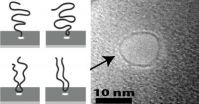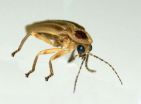Most physicians do not meet Medicare quality reporting requirements
Radiologists nearly twice as likely as other providers to qualify for PQRS bonuses
2013-01-08
(Press-News.org) Washington, DC – A new Harvey L. Neiman Health Policy Institute study shows that fewer than one-in-five healthcare providers meet Medicare Physician Quality Reporting System (PQRS) requirements. Those that meet PQRS thresholds now receive a .5 percent Medicare bonus payment. In 2015, bonuses will be replaced by penalties for providers who do not meet PQRS requirements. As it stands, more than 80 percent of providers nationwide would face these penalties.
Researchers analyzed 2007-2010 PQRS program data and found that nearly 24 percent of eligible radiologists qualified for PQRS incentives in 2010 — compared to 16 percent for other providers. The Neiman Institute study is published online in the Journal of the American College of Radiology.
"Near term improvements in documentation and reporting are necessary to avert widespread physician penalties. As it stands, in 2016, radiologists collectively may face penalties totaling more than $100 Million. Although not a specific part of this analysis, penalties for nonradiologists could total well over $1 Billion," said Richard Duszak, MD, chief executive officer and senior research fellow of the Harvey L. Neiman Health Policy Institute. "Compliance with PQRS requirements has improved each year but more physicians need to act now: their performance in 2013 will dictate penalties for 2015."
###
The Neiman Institute conducts and supports research regarding medical imaging use, quality and safety metrics, and human resources as medicine moves toward non-traditional, value-based payment and delivery. The data gleaned from these efforts will serve as the basis for true, evidence-based medical imaging and health care policy.
To read the study, visit: http://bit.ly/UmOQ3o
For more information regarding the Neiman Health Policy Institute, visit neimanhpi.org.
To arrange an interview with a spokesperson, contact Shawn Farley at 703-648-8936 or PR@acr.org.
The Harvey L. Neiman Health Policy Institute is one of the nation's leading medical imaging socioeconomic research organizations. The Neiman Institute studies the role and value of radiology and radiologists in evolving health care delivery and payment systems and the impact of medical imaging on the cost, quality, safety, and efficiency of health care.
END
ELSE PRESS RELEASES FROM THIS DATE:
2013-01-08
Researchers at UCLA say it's not just what you eat that makes those pants tighter — it's also genetics. In a new study, scientists discovered that body-fat responses to a typical fast-food diet are determined in large part by genetic factors, and they have identified several genes they say may control those responses.
The study is the first of its kind to detail metabolic responses to a high-fat, high-sugar diet in a large and diverse mouse population under defined environmental conditions, modeling closely what is likely to occur in human populations. The researchers ...
2013-01-08
JACKSONVILLE, Fla. — Most people know a colonoscopy requires some preparation by the patient. Now, a Mayo Clinic physician suggests an additional step to lower the risk of colorectal cancer: Ask for your doctor's success rate detecting easy-to-miss polyps called adenomas.
The measure of success is called the adenoma detection rate, or ADR, and has been linked to a reduced risk of developing a new cancer after the colonoscopy. The current recommended national benchmark is at least 20 percent, which means that an endoscopist should be able to detect adenomas in at least ...
2013-01-08
New York, NY — A new study led by Columbia University Medical Center (CUMC) researchers has found that leptin, a hormone that plays a key role in energy metabolism, fertility, and bone mass, also regulates airway diameter. The findings could explain why obese people are prone to asthma and suggest that body weight–associated asthma may be relieved with medications that inhibit signaling through the parasympathetic nervous system, which mediates leptin function. The study, conducted in mice, was published in the online edition of the journal Cell Metabolism.
"Our study ...
2013-01-08
Clinical pharmacologist Jens Titze, M.D., knew he had a one-of-a-kind scientific opportunity: the Russians were going to simulate a flight to Mars, and he was invited to study the participating cosmonauts.
Titze, now an associate professor of Medicine at Vanderbilt University, wanted to explore long-term sodium balance in humans. He didn't believe the textbook view – that the salt we eat is rapidly excreted in urine to maintain relatively constant body sodium levels. The "Mars500" simulation gave him the chance to keep salt intake constant and monitor urine sodium levels ...
2013-01-08
Researchers have found new evidence that metabolic stress can increase the onset of atrial arrhythmias, such as atrial fibrillation (AF), a common heart condition that causes an irregular and often abnormally fast heart rate. The findings may pave the way for the development of new therapies for the condition which can be expected to affect almost one in four of the UK population at some point in their lifetime.
The British Heart Foundation (BHF) study, led by University of Bristol scientists and published in Circulation: Arrhythmia and Electrophysiology, found that metabolic ...
2013-01-08
PROVIDENCE, R.I. [Brown University] — If you want to understand a novel, it helps to start from the beginning rather than trying to pick up the plot from somewhere in the middle. The same goes for analyzing a strand of DNA. The best way to make sense of it is to look at it head to tail.
Luckily, according to a new study by physicists at Brown University, DNA molecules have a convenient tendency to cooperate.
The research, published in the journal Physical Review Letters, looks at the dynamics of how DNA molecules are captured by solid-state nanopores, tiny holes that ...
2013-01-08
The nighttime twinkling of fireflies has inspired scientists to modify a light-emitting diode (LED) so it is more than one and a half times as efficient as the original. Researchers from Belgium, France, and Canada studied the internal structure of firefly lanterns, the organs on the bioluminescent insects' abdomens that flash to attract mates. The scientists identified an unexpected pattern of jagged scales that enhanced the lanterns' glow, and applied that knowledge to LED design to create an LED overlayer that mimicked the natural structure. The overlayer, which increased ...
2013-01-08
For over 100 years, it was assumed that the penicillin-producing mould fungus Penicillium chrysogenum only reproduced asexually through spores. An international research team led by Prof. Dr. Ulrich Kück and Julia Böhm from the Chair of General and Molecular Botany at the Ruhr-Universität has now shown for the first time that the fungus also has a sexual cycle, i.e. two "genders". Through sexual reproduction of P. chrysogenum, the researchers generated fungal strains with new biotechnologically relevant properties - such as high penicillin production without the contaminating ...
2013-01-08
Athens, Ga. – On the list of undesirable medical conditions, a parasitic worm infection surely ranks fairly high. Although modern pharmaceuticals have made them less of a threat in some areas, these organisms are still a major cause of disease and disability throughout much of the developing world.
But parasites are not all bad, according to new research by a team of scientists now at the University of Georgia, the Harvard School of Public Health, the Université François Rabelais in Tours, France, and the Central South University, Changsha, Hunan, China.
A study ...
2013-01-08
The research carried out at IIASA in collaboration with the Potsdam Institute for Climate Impact Research demonstrates that there is fundamental rigidity, known as lock-in, within the energy economy that favors the use of fossil fuels and nuclear power despite their large environmental and social costs. The researchers identify that this rigidity of the existing energy economy could be considerably reduced by introducing new rules that hold shareholders of companies liable for the damages caused by the companies they own. Allocating the liability between the company and ...
LAST 30 PRESS RELEASES:
[Press-News.org] Most physicians do not meet Medicare quality reporting requirements
Radiologists nearly twice as likely as other providers to qualify for PQRS bonuses

